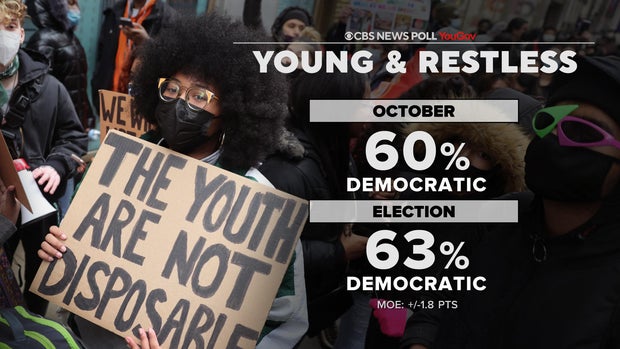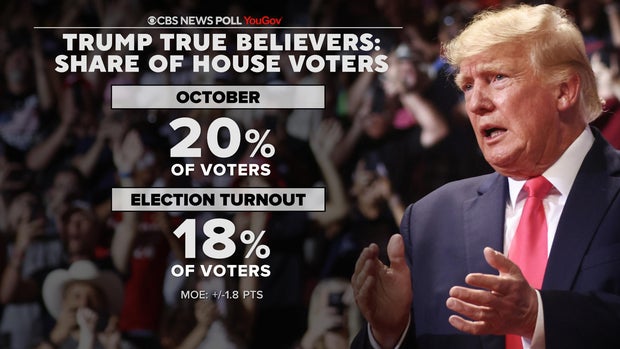Before the midterm elections, the contest had been framed — by the parties and voters alike — as concerns about economic forces set against concerns about rights and democracy. Those forces remained through Election Day, when our key groups of influencers really held sway.
Here we unpack some of that influence from our exclusive CBS News election voter poll, which was unveiled on election night.
What gave Republicans their (narrow) edge?
“Pressured Parents”
The Republicans will probably win the national House vote in part helped by these voters, albeit narrowly. These were parents who have experienced post-pandemic stress over their finances and their kids. And they reflected the nation by voting narrowly Republican.
Their share of the electorate grew from our pre-election estimates of 13% up to 19% on Election Day, and they narrowly backed Republicans for the House. That larger size may reflect growing concerns about finances among the electorate, and most of them did report getting more pessimistic in the closing weeks.
However, Democrats did close the gap with them slightly over the fall, reflecting an overall tighter contest. Pressured parents were 47-40 for Republicans in October, and ended up 50-47 Republican by Election Day. Those who decided late (though not too numerous) broke toward the Democrats.
They fell along general campaign themes. Those who reported growing concerns about finances broke toward the Republicans, while those reporting growing concerns about democracy or political violence broke toward the Democrats.
What kept Democrats competitive?
“The Young and Restless”
These voters got up and went to the polls, and did so in slightly higher proportion for Democrats than they were leaning in October. All this helped the Democrats keep things close, as our pre-election models had anticipated it could.
Not all had indicated they definitely would vote in the months prior to the election, leaving them as a key group to watch. This echoed the national exit polls (which use a wider definition set of under-30s that includes those with children) that likewise suggested younger voters did turn out in numbers approaching their 2018 proportions, to help Democrats.
How did abortion factor in?
“Restoring Roe” Voters
This group is women who prioritized abortion rights.
They started as strongly Democratic in October and only increased further, going from 81% Democratic to an overwhelming 90% in the final vote.
This suggests Democrats’ messaging about which party to choose to express their concern — and about what to prioritize — was successful.
For nine in 10 of them, they reported this election was more about personal freedoms than it was about personal finances. So, despite most of them calling the economy bad, they voted on abortion — and for Democrats — anyway.
In fact, to the extent any reported changing views on the economy in recent weeks, more became pessimistic about the economy than became optimistic. Still voted for Democrats.
Their share of the electorate did not grow from October, but the added proportion of Democratic vote surely helped keep many House races closer on net.
And the impact of the political right?
Trump True Believers
These Republicans identify as part of the “MAGA” movement and voted — unsurprisingly — overwhelmingly for Republicans. They made up 18% of voters in our estimates, slightly lower than the 20% they were in our pre-election polling, offset to some extent by turnout from other groups. Some of this might have amounted to the relative difference between a lean GOP House majority and a larger one.
But in terms of overall influence, they’d had a lot of impact on the party — and thus were worth watching — including their influence on the candidates the party had selected during the year and the messaging they promoted. Some of the high-profile candidates who advanced in primaries did not ultimately fare well in a lot of races, including losing in Pennsylvania and Michigan, suggesting that may have turned off some more centrist voters.
This CBS News/YouGov survey is based on 3,933 interviews of voters. An initial survey was conducted between Nov. 3-7, 2022, using a nationally representative sample of 5,210 U.S. registered voters to determine likely voters. 3,933 voters were included in the final analysis. 3,261 likely voters who had not yet voted at the time of the initial survey were recontacted on Election Day, Nov. 8, 2022, for a short reinterview. 2,125 responded — a recontact rate of 65%. The final sample of voters was weighted to be representative of likely voters according to gender, age, race, education, geographic region, and partisan identification. During election night, the weighting incorporated current estimates of the total national aggregate house vote as reported vote came in. The margin of error for the entire sample is +/- 1.8 pts.





